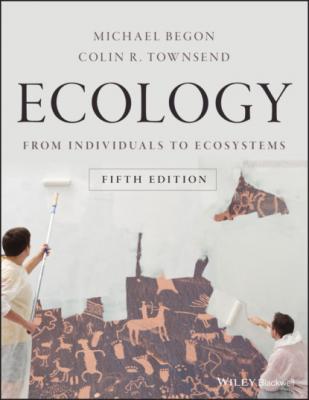Ecology. Michael Begon
Читать онлайн.| Название | Ecology |
|---|---|
| Автор произведения | Michael Begon |
| Жанр | Биология |
| Серия | |
| Издательство | Биология |
| Год выпуска | 0 |
| isbn | 9781119279310 |
5.9.3 A single boundary line for all species?
Intriguingly, when the thinning and boundary lines of all sorts of plants are plotted on the same figure, they all appear to have approximately the same slope and also to have intercepts (i.e. values of c in Equation 5.24) falling within a narrow range (Figure 5.37). To the lower right of the figure are high‐density populations of small plants (annual herbs and perennials with short‐lived shoots), while to the upper left are sparse populations of very large plants, including coastal redwoods (Sequoia sempervirens), the tallest known trees. Fashions change in science as in everything else. At one time, ecologists looked at Figure 5.37 and saw uniformity – all plants marching in −3/2 time, with variations from the norm seen either as ‘noise’ or of only minor interest (e.g. White, 1980). Subsequently, however, serious doubt was cast on the conformity of individual slopes to −3/2, and on the whole idea of a single, ideal thinning line (Weller, 1987 , 1990 ; Zeide, 1987; Lonsdale, 1990). This is reminiscent of discussions we described in Section 3.9 about whether there is a general rule (and a common slope) at the heart of a metabolic theory of ecology, and again, there really is no contradiction. On the one hand, the lines in Figure 5.37 occupy a very much smaller portion of the graph than one would expect by chance alone. There is apparently some fundamental phenomenon linking this whole spectrum of plant types: not an invariable ‘rule’ but an underlying trend. On the other hand, the variations between the lines are real and important and in as much need of explanation as the general trend.
Figure 5.37 Self‐thinning in a wide variety of herbs and trees. Each line is a different species, and the line itself indicates the range over which observations were made. The blue arrows, drawn on representative lines only, indicate the direction of self‐thinning over time. The figure is based on Figure 2.9 of White (1980), which also gives the original sources and the species names for the 31 datasets.
5.9.4 An areal basis for self‐thinning
We proceed, therefore, by examining possible bases for the general trend, and then asking why different species or populations might display their own variations on this common theme. Two broad types of explanation for the trend have been proposed. The first (and for many years the only one) is areal and based on a resource falling on the organisms from above (like light); the second is based on resource allocation in organisms of different sizes. Again, the similarities to the arguments at the heart of a metabolic theory of ecology, discussed in Section 3.9, are clear.
Limiting ourselves for now to plants, the areal argument runs as follows. In a growing cohort, as the mass of the population increases, the leaf area index (L, the leaf area per unit area of land) does not keep on increasing because beyond a certain point the canopy is full and so L remains constant irrespective of plant density (N). It is, in fact, precisely beyond this point that the population follows the dynamic thinning line. We can express this by saying that beyond this point:
where λ is the mean leaf area per surviving plant. However, the leaf area of individual plants increases as they grow, and so too therefore does their mean, λ. We expect λ, because it is an area, to be related to linear measurements of a plant, such as stem diameter, D, by a formula of the following type:
where a is a constant. Similarly, we expect mean plant weight, P, to be related to D by:
where b is also a constant. Putting Equations 5.26–5.28 together, we obtain:
This is structurally equivalent to the −3/2 power relationship in Equation 5.23, with the intercept constant, c, given by b(L/a) 3/2.
It is apparent, therefore, why thinning lines might generally be expected to have slopes of approximately −3/2. Moreover, if the relationships in Equations 5.27 and 5.28 were roughly the same for all plant species, and if all plants supported roughly the same leaf area per unit area of ground (L), then the constant c would be approximately the same for all species. On the other hand, suppose that L is not quite the same for all species, or that the powers in Equations 5.27 and 5.28 are not exactly 2 or 3, or that the constants in these equations (a and b) either vary between species or are not actually constants at all. Thinning lines will then have slopes that depart from −3/2, and slopes and intercepts that vary from species to species. It is easy to see why, according to the areal argument, there is a broad similarity in the behaviour of different species, but also why, on closer examination, there are likely to be variations between species and no such thing as a single, ‘ideal’ thinning line.
complications of the areal argument
Furthermore, contrary to the simple areal argument, the yield–density relationship in a growing cohort need not depend only on the numbers that die and the way the survivors grow. We have seen (see Section 5.8) that competition is frequently
